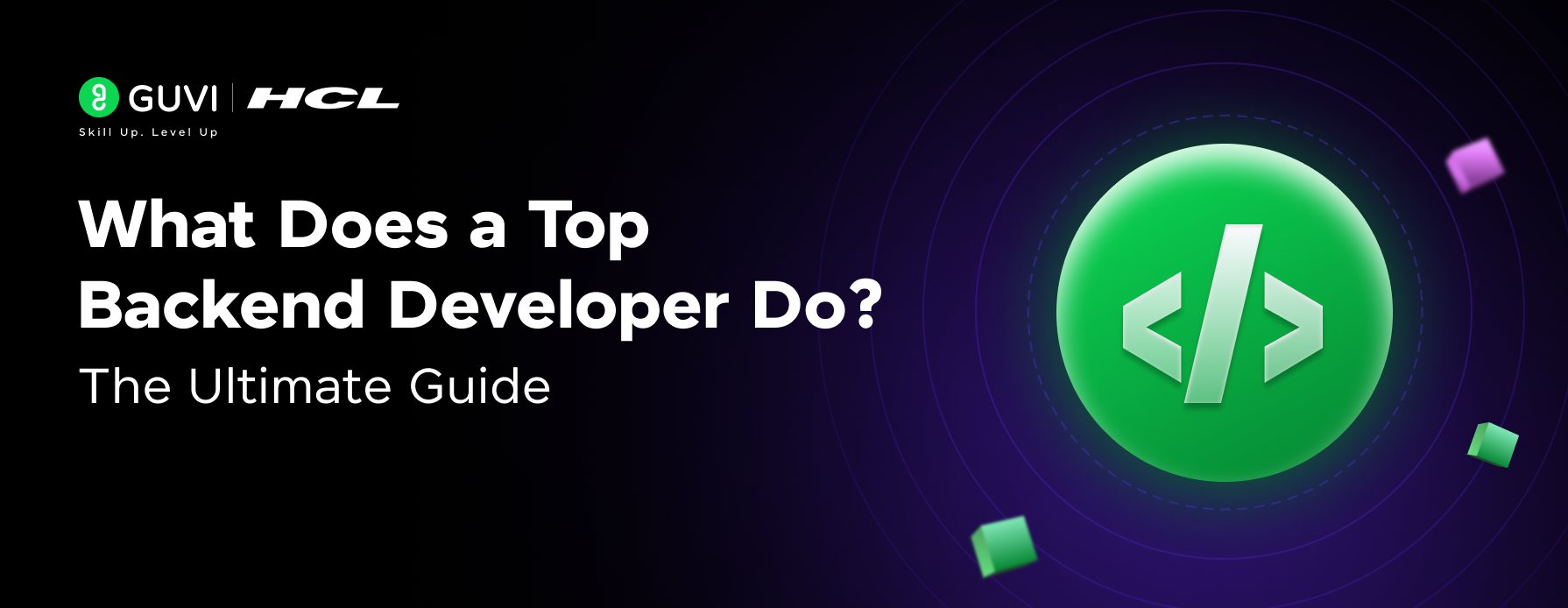
What Does a Top Backend Developer Do? The Ultimate Guide
Apr 08, 2025 6 Min Read 3723 Views
(Last Updated)
Have you ever wondered how websites like Amazon, Netflix, or Facebook handle millions of users simultaneously without crashing? The answer lies in backend development—the invisible engine that powers the functionality of web applications.
They work behind the scenes, managing databases, servers, APIs, security, and performance optimization, making sure everything runs smoothly.
In this comprehensive guide, we will explore the responsibilities, skills, tools, and salary prospects of a backend developer. So, if you are curious about what goes on behind the scenes of a website, read on!
Table of contents
- What is Backend Development?
- What Does a Backend Developer Do?
- Key Responsibilities of a Backend Developer:
- Skills for a Backend Developer
- Tools Required For Backend Development
- 1) Programming Languages
- 2) Backend Frameworks
- 3) Database Management Systems
- 4) Version Control Systems
- 5) Other Tools
- Average Backend Developer Salary
- How to Become a Backend Developer?
- Conclusion
- FAQs
- What is the primary role of a backend developer?
- What programming languages are commonly used in backend development?
- How do backend developers ensure the security of web applications?
- What is the difference between SQL and NoSQL databases, and when should each be used?
- Can you explain what RESTful APIs are and their importance in backend development?
What is Backend Development?
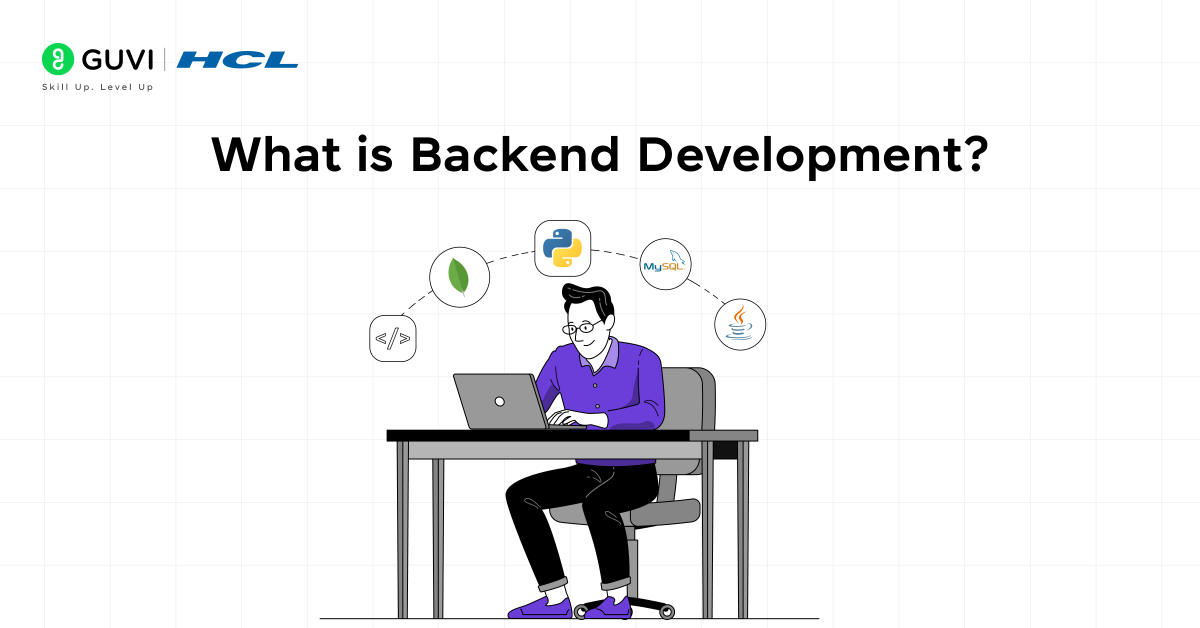
Backend development refers to the server-side aspect of web development, focusing on the logic, databases, and APIs that drive a website or web application.
It involves data management, server configuration, security protocols, and system integrations to ensure cohesive and efficient operation.
Backend development is the backbone of websites and web applications, ensuring seamless functionality and robust performance. While frontend development captures the user’s attention with visual elements, backend development powers the unseen processes that make applications work effectively.
What Does a Backend Developer Do?
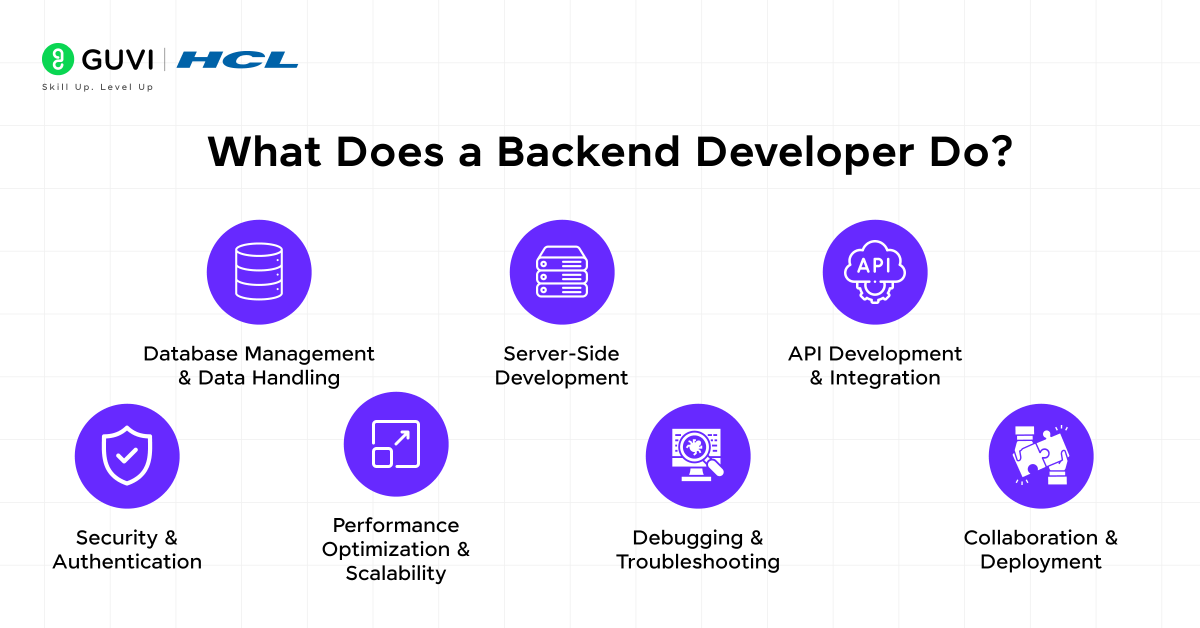
A backend developer is responsible for the server-side logic, databases, APIs, and application architecture that power websites and applications. While frontend developers handle the visual and interactive aspects, backend developers ensure that data is processed, stored, and delivered securely and efficiently.
Key Responsibilities of a Backend Developer:
- Database Management & Data Handling
- Design, develop, and maintain databases (SQL – MySQL, PostgreSQL | NoSQL – MongoDB, Firebase).
- Optimize database queries to store, retrieve, and manage large volumes of data efficiently.
- Implement data modeling and indexing to improve application performance.
- Server-Side Development
- Write backend logic using server-side languages such as Python, Java, PHP, Ruby, or JavaScript (Node.js).
- Develop and implement algorithms that process user requests and return responses efficiently.
- Use backend frameworks like Django, Spring Boot, Express.js, or Ruby on Rails to streamline development.
- API Development & Integration
- Design and maintain RESTful and GraphQL APIs to connect the frontend with the backend.
- Ensure seamless communication between different components of the application, such as databases, third-party services, and frontend applications.
- Security & Authentication
- Implement security measures like OAuth, JWT, SSL, and data encryption to prevent unauthorized access and data breaches.
- Handle user authentication and authorization to ensure only permitted users can access certain resources.
- Regularly test for vulnerabilities such as SQL injection, cross-site scripting (XSS), and other cyber threats.
- Performance Optimization & Scalability
- Optimize server performance by caching, load balancing, and database indexing.
- Improve application response times by fine-tuning backend processes.
- Ensure the system is scalable to handle increased traffic and user demands over time.
- Debugging & Troubleshooting
- Identify and fix bugs, errors, and performance bottlenecks in the backend code.
- Use logging and monitoring tools (e.g., ELK Stack, Sentry) to track and resolve issues proactively.
- Collaboration & Deployment
- Work closely with frontend developers, DevOps engineers, UI/UX designers, and product managers to ensure smooth development and deployment.
- Deploy applications using cloud platforms like AWS, Google Cloud, or Azure.
- Use CI/CD pipelines (Jenkins, GitHub Actions) for continuous integration and deployment.
Skills for a Backend Developer
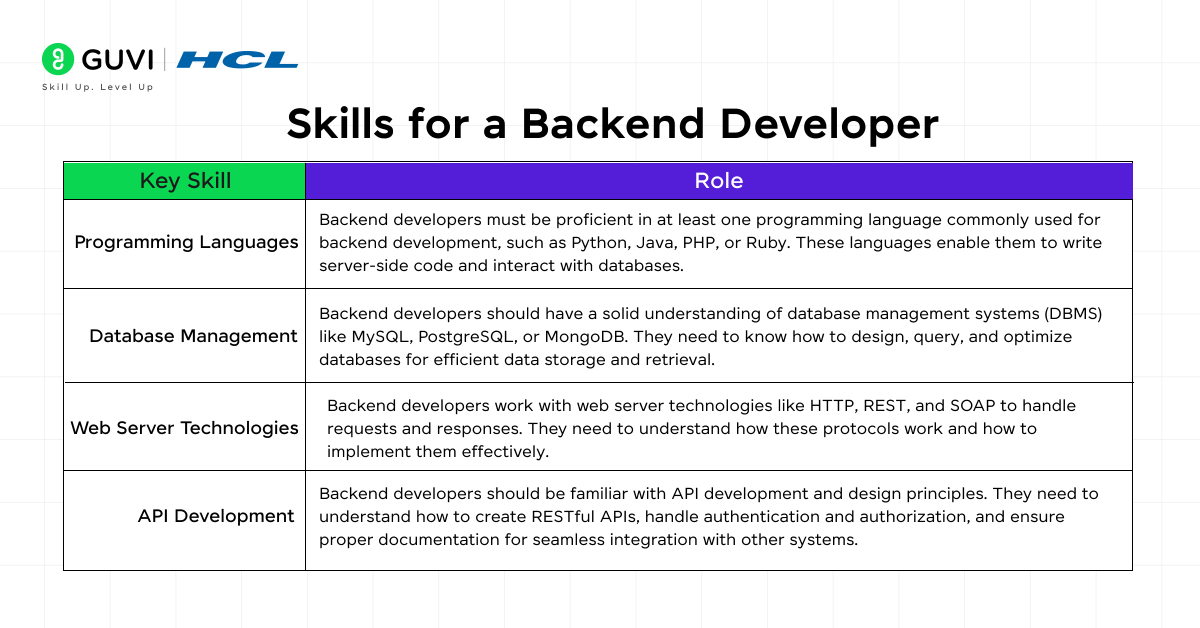
To excel as a backend developer, certain skills are crucial. Let’s explore the key skills that make a competent backend developer:
- Programming Languages: Backend developers must be proficient in at least one programming language commonly used for backend development, such as Python, Java, PHP, or Ruby. These languages enable them to write server-side code and interact with databases.
- Database Management: Backend developers should have a solid understanding of database management systems (DBMS) like MySQL, PostgreSQL, or MongoDB. They need to know how to design, query, and optimize databases for efficient data storage and retrieval.
- Web Server Technologies: Backend developers work with web server technologies like HTTP, REST, and SOAP to handle requests and responses. They need to understand how these protocols work and how to implement them effectively.
- API Development: Backend developers should be familiar with API development and design principles. They need to understand how to create RESTful APIs, handle authentication and authorization, and ensure proper documentation for seamless integration with other systems.
- Version Control: Proficiency in using version control systems like Git is essential for backend developers. Version control allows developers to collaborate, track changes, and roll back to previous versions when necessary.
- Problem-Solving and Troubleshooting: Backend developers must possess strong problem-solving and troubleshooting skills. They need to be able to analyze complex issues, identify the root cause of problems, and implement effective solutions.
- Communication and Collaboration: Effective communication and collaboration are essential for backend developers. They need to work closely with cross-functional teams, including frontend developers, designers, and project managers, to ensure smooth coordination and successful project delivery.
Tools Required For Backend Development
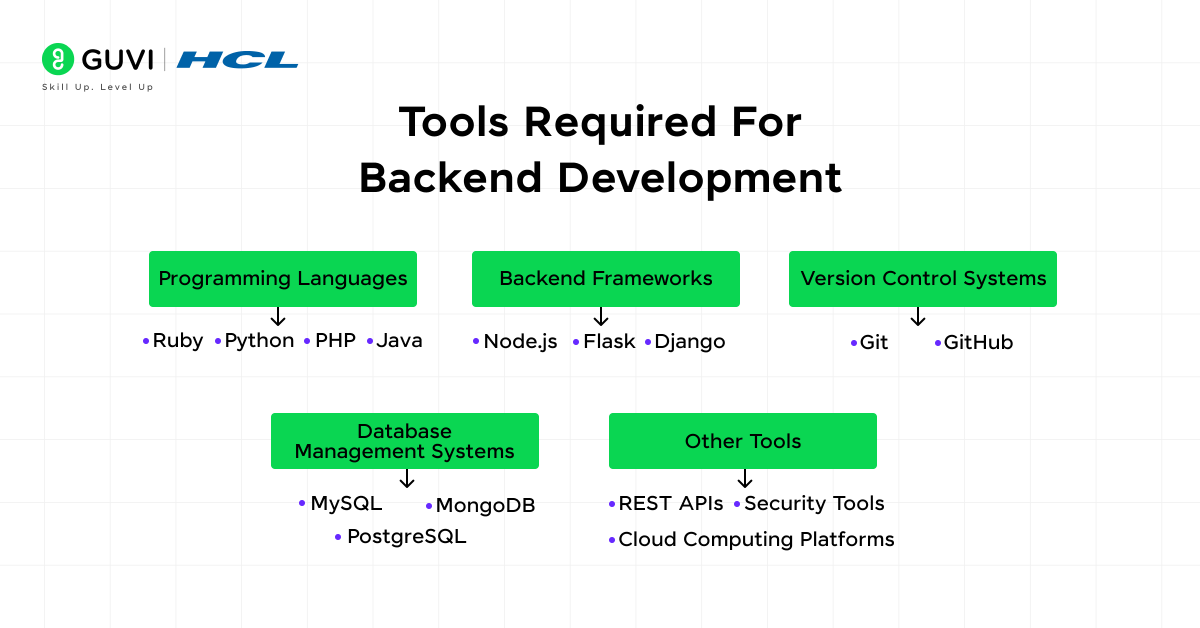
Backend developers rely on a wide range of tools and technologies to carry out their work efficiently. Let’s explore some of the essential tools used by backend developers:
1) Programming Languages
- Python: Python is a popular choice for backend development due to its simplicity, versatility, and extensive libraries for web development. It is widely used in areas like data analysis, machine learning, and web scraping.
- Java: Java is a robust and widely adopted programming language for backend development. It provides a secure and scalable environment for building enterprise-level applications.
- PHP: PHP is a server-side scripting language specifically designed for web development. It powers many popular content management systems like WordPress and Drupal.
- Ruby: Ruby, along with the Ruby on Rails framework, offers a productive and elegant solution for backend development. It emphasizes simplicity and convention over configuration.
2) Backend Frameworks
- Node.js: Node.js is a JavaScript runtime environment that allows developers to build scalable, high-performance web applications. It leverages an event-driven, non-blocking I/O model, making it ideal for real-time applications.
- Flask: Flask is a lightweight web framework for Python. It provides a simple yet powerful foundation for building web applications and APIs.
- Django: Django is a high-level Python web framework that follows the model-view-controller (MVC) architectural pattern. It provides a robust set of tools and features for rapid development.
3) Database Management Systems
- MySQL: MySQL is a popular open-source relational database management system (RDBMS) known for its scalability and performance. It is widely used in web applications and content management systems.
- PostgreSQL: PostgreSQL is another powerful open-source RDBMS that emphasizes data integrity and extensibility. It offers advanced features like full-text search, geospatial data support, and JSON storage.
- MongoDB: MongoDB is a NoSQL document-oriented database that provides high flexibility and scalability. It is particularly suitable for handling large volumes of unstructured data.
4) Version Control Systems
- Git: Git is a distributed version control system that allows developers to track changes to their codebase. It enables collaboration, facilitates code reviews, and provides a reliable backup of the project’s history.
- GitHub: GitHub is a web-based hosting service for Git repositories. It offers additional collaboration features, such as issue tracking, pull requests, and project management tools.
5) Other Tools
- REST APIs: Representational State Transfer (REST) is an architectural style for designing networked applications. Backend developers often work with REST APIs to create, consume, and integrate data from different sources.
- Cloud Computing Platforms: Cloud computing platforms like Amazon Web Services (AWS), Microsoft Azure, and Google Cloud Platform (GCP) provide scalable infrastructure and services for hosting and deploying backend applications.
- Security Tools: Backend developers use various security tools and practices to protect applications from vulnerabilities and attacks. These may include encryption algorithms, secure coding practices, and penetration testing.
Average Backend Developer Salary
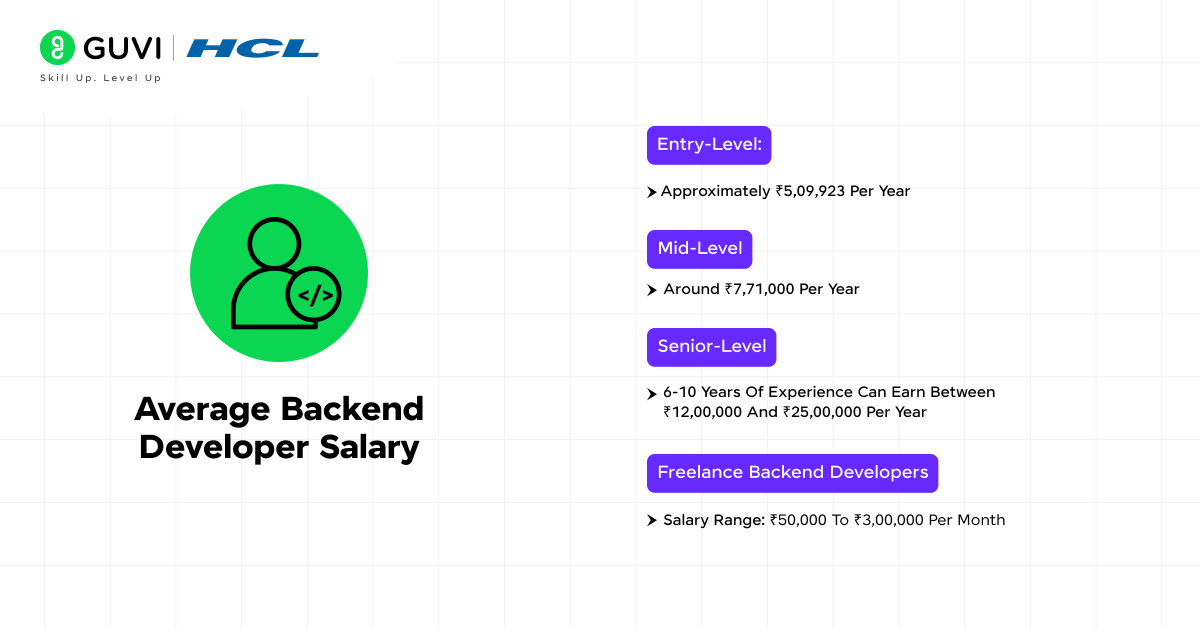
Backend developers are in high demand, and their salaries reflect their expertise and the value they bring to organizations. The average backend developer salary varies based on factors such as experience, location, and industry.
Backend developers are in high demand in India, with compensation reflecting their expertise and the critical nature of their work. Salaries vary based on experience, location, and industry.
- Entry-Level: Approximately ₹5,09,923 per year.
- Mid-Level: Around ₹7,71,000 per year for backend developers with 3-6 years of experience. With expertise in high-demand frameworks and cloud technologies, this figure can rise significantly.
- Senior-Level: Senior backend developers with over 6-10 years of experience can earn between ₹12,00,000 and ₹25,00,000 per year. Those in leadership roles or specializing in niche areas like AI, blockchain, or distributed systems can command even higher salaries.
- Freelance Backend Developers: Freelancers or contract-based backend developers in India can earn ₹50,000 to ₹3,00,000 per month depending on their expertise, client base, and project scope.
According to Glassdoor, the average backend developer salary in India is around ₹ 6,00,000 per year. However, salaries can range from ₹4,00,000 to ₹12,00,000 or more, depending on the specific role and location.
It’s worth noting that these figures are subject to variations based on factors such as company size, industry, and additional skills or certifications.
How to Become a Backend Developer?
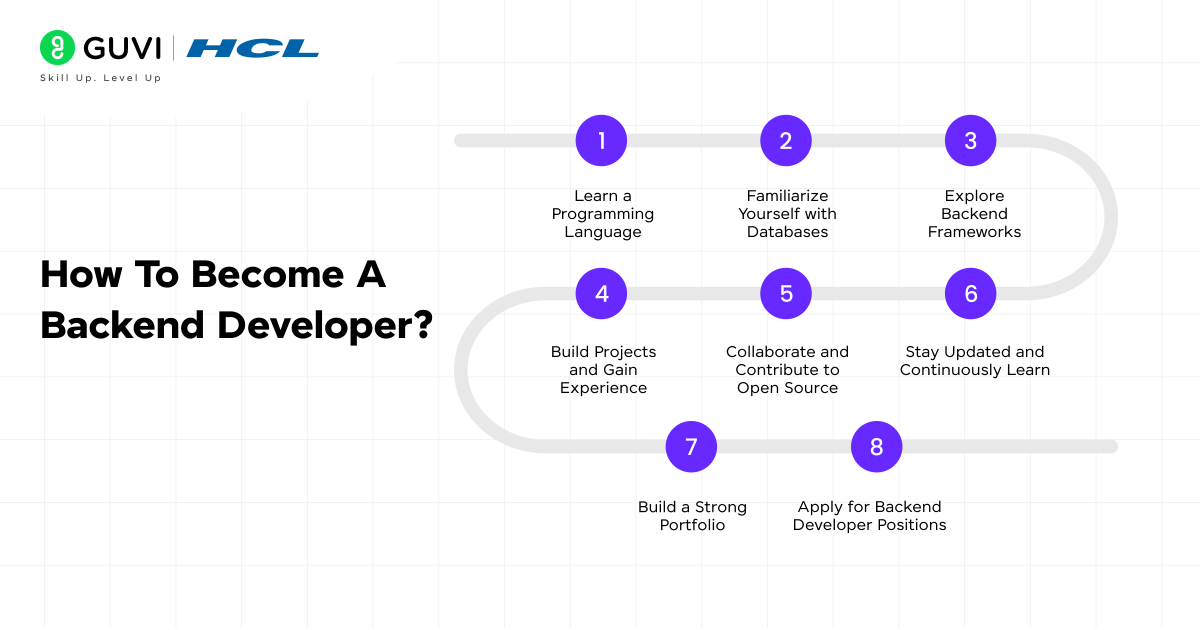
Becoming a backend developer requires a combination of technical skills, hands-on experience, and continuous learning. Here are some steps you can take to kickstart your journey as a backend developer:
- Learn a Programming Language: Start by mastering a programming language commonly used for backend development, such as Python, Java, or PHP. Online tutorials, courses, and coding boot camps offer a structured learning path to get you started.
- Familiarize Yourself with Databases: Gain a solid understanding of database management systems (DBMS) and learn how to interact with databases using SQL or NoSQL technologies. Practice designing and querying databases to become proficient in data management.
- Explore Backend Frameworks: Dive into backend frameworks like Node.js, Flask, or Django to accelerate your development process. Learn how to build APIs, handle routing, and connect frontend and backend components.
- Build Projects and Gain Experience: Put your skills into practice by building real-world projects. Create web applications, design APIs, and work with databases to gain hands-on experience and showcase your abilities to potential employers.
- Collaborate and Contribute to Open Source: Join online communities and contribute to open-source projects to enhance your skills and network with experienced developers. Collaborating on projects allows you to learn from others and improve your coding practices.
- Stay Updated and Continuously Learn: Backend development is a rapidly evolving field. Stay updated with the latest trends, best practices, and emerging technologies. Explore online resources, attend webinars, and participate in relevant courses to keep expanding your knowledge.
- Build a Strong Portfolio: Assemble a portfolio of your projects and showcase your skills to potential employers. Highlight your contributions, the problems you solved, and the impact you made on each project.
- Apply for Backend Developer Positions: Once you feel confident in your skills and have a strong portfolio, start applying for backend developer positions. Tailor your resume and cover letter to highlight your relevant experience and skills. Prepare for technical interviews and be ready to demonstrate your problem-solving abilities.
If you want to become a backend developer, kickstart your full-stack development journey by enrolling in GUVI’s Certified Full-stack development course that not only teaches you the basics but also gives you practical experience through real-life full-stack development projects
Conclusion
In conclusion, backend development is a critical aspect of web development, focusing on the server-side logic, databases, and APIs that power websites and web applications. Backend developers play a crucial role in ensuring smooth functionality, data management, security, and integration of different systems.
By acquiring the necessary skills, staying updated with emerging technologies, and gaining practical experience, you can embark on a rewarding career as a backend developer.
FAQs
A backend developer is responsible for building and maintaining the server-side logic, databases, and APIs of a web application. They ensure that data is processed, stored, and retrieved efficiently, manage user authentication and authorization, and implement security measures to protect against vulnerabilities.
Backend developers often work with languages such as Python, Java, PHP, Ruby, and JavaScript (Node.js). The choice of language depends on the specific requirements of the project, existing technology stacks, and performance considerations.
To secure web applications, backend developers implement measures like data encryption, user authentication and authorization protocols, input validation to prevent SQL injection and cross-site scripting (XSS), and regular security audits to identify and address potential vulnerabilities.
SQL databases are relational and use structured query language for defining and manipulating data, making them suitable for applications requiring complex queries and transactions.
NoSQL databases are non-relational and can store unstructured data, offering flexibility and scalability, which is ideal for applications dealing with large volumes of diverse data types.
RESTful APIs (Representational State Transfer) are a set of principles that define how web services should be designed, allowing different systems to communicate over HTTP. They are crucial in backend development for enabling seamless interaction between the server and client, facilitating data exchange, and integrating third-party services.

























![What is TypeScript? A Beginner's Guide [2025] 11 typescript](https://www.guvi.in/blog/wp-content/uploads/2025/05/What-is-TypeScript_-A-Beginners-Guide.png)

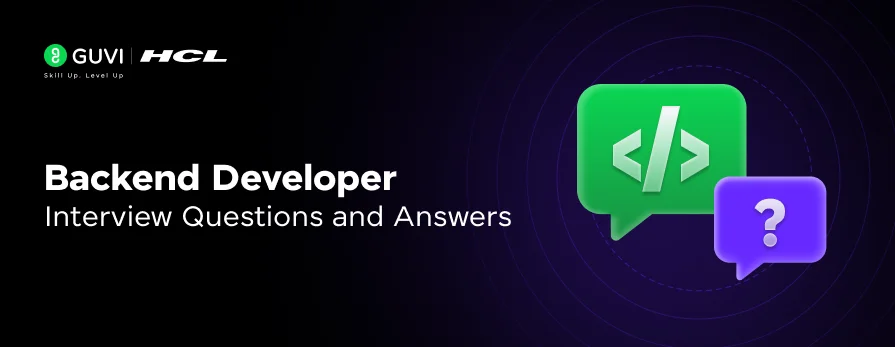
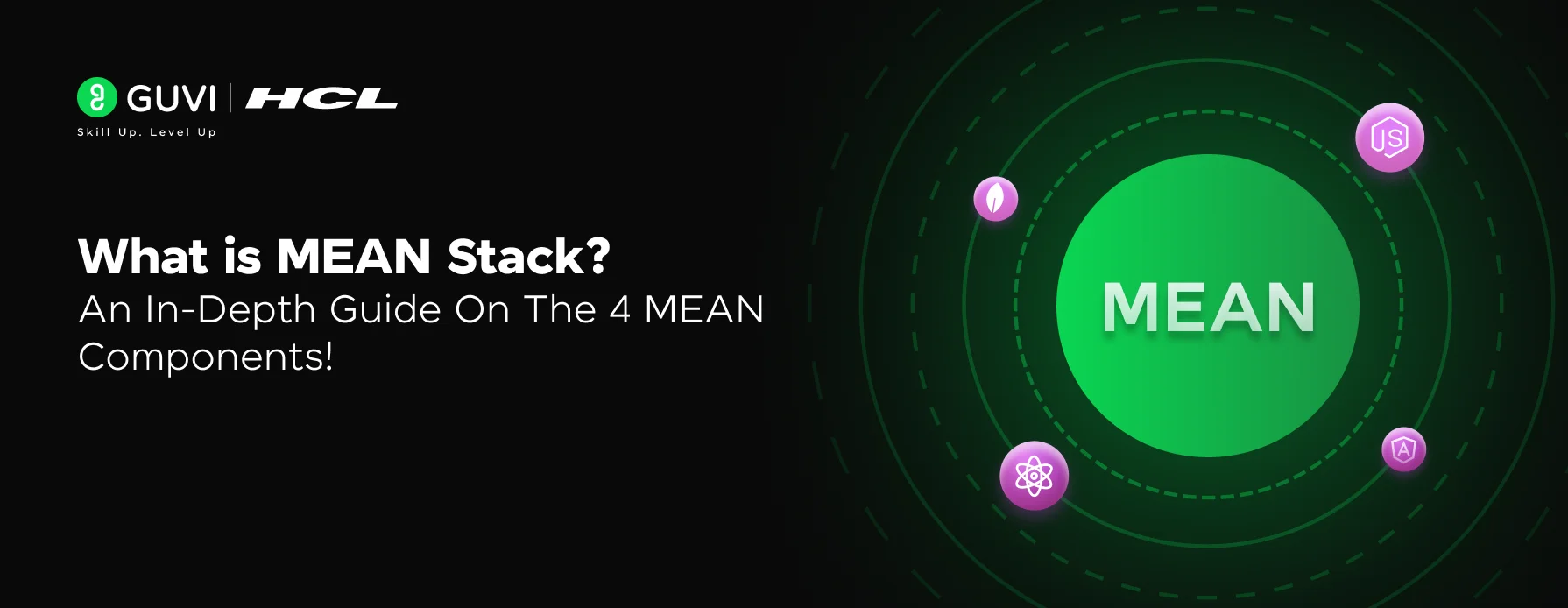
![What is ReactJS? A Beginner's Guide [2025] 14 what is reactjs](https://www.guvi.in/blog/wp-content/uploads/2025/04/What-is-ReactJS_-A-Beginners-Guide.png)
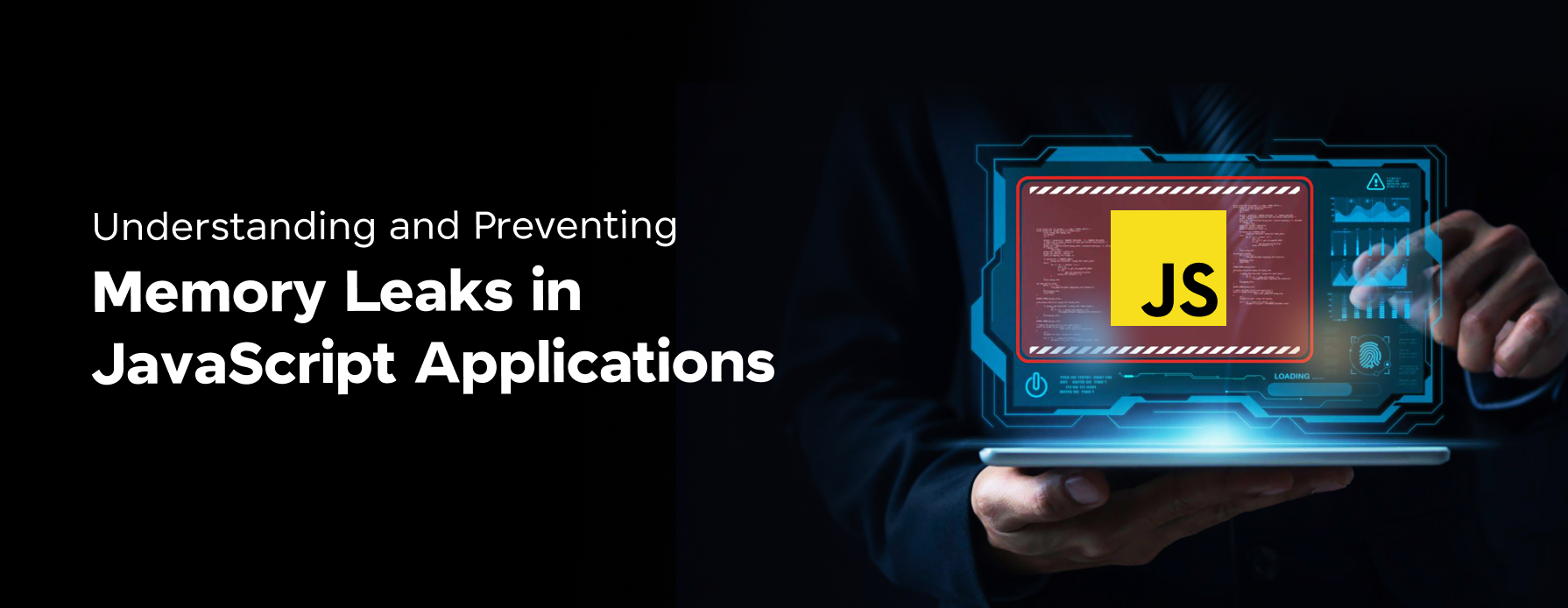

Did you enjoy this article?